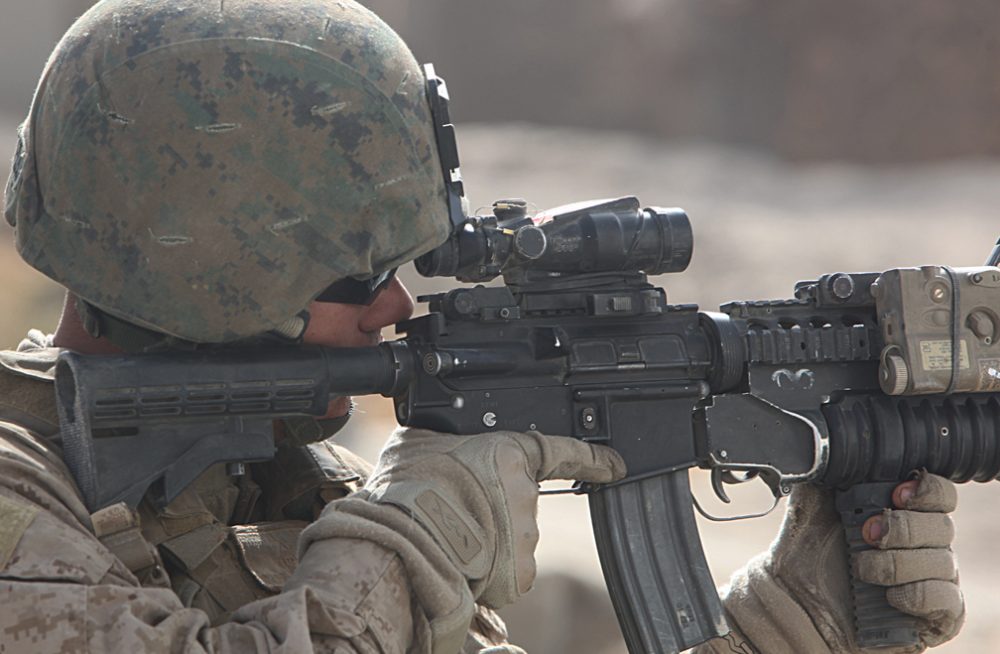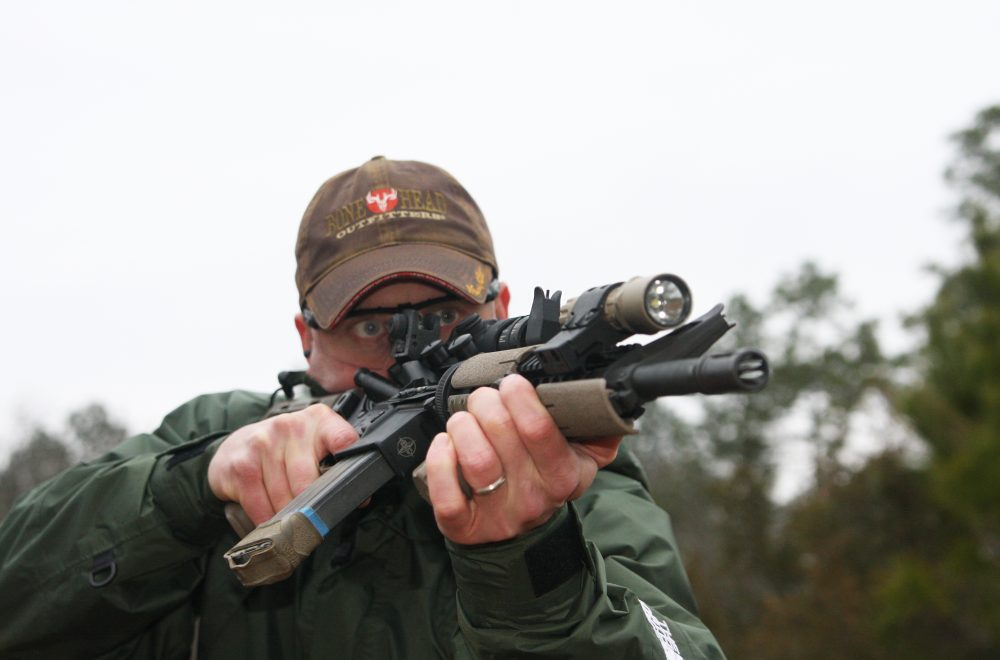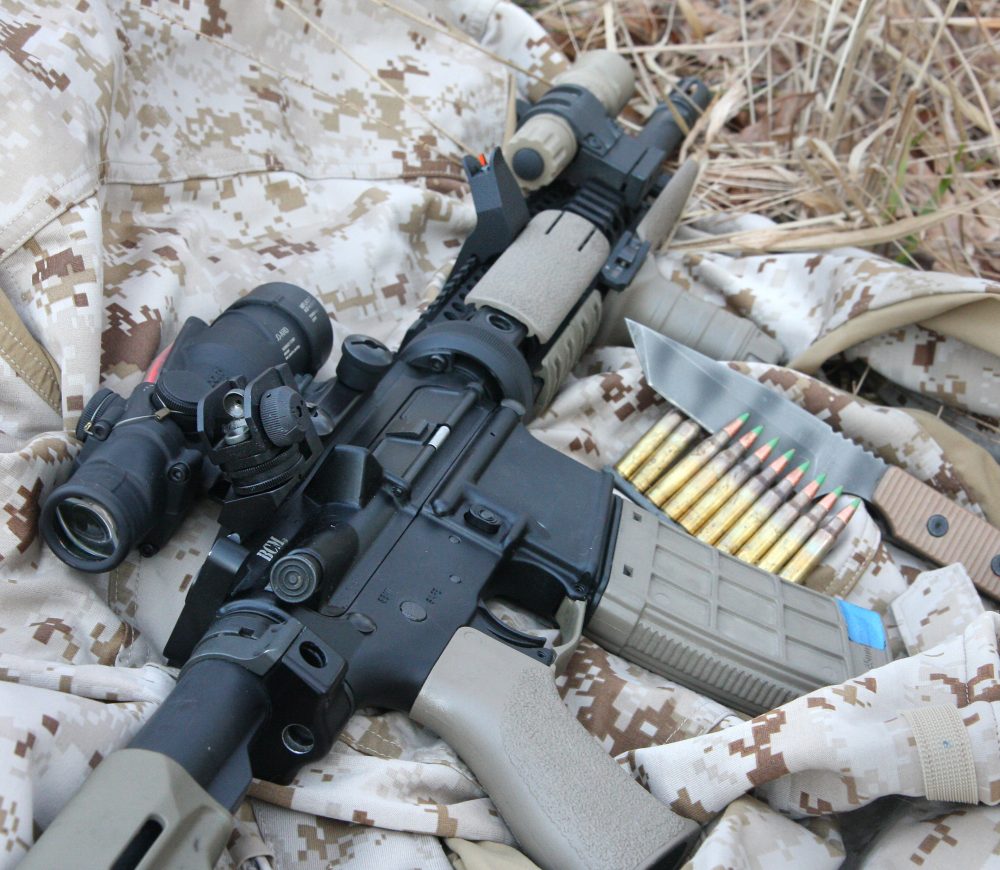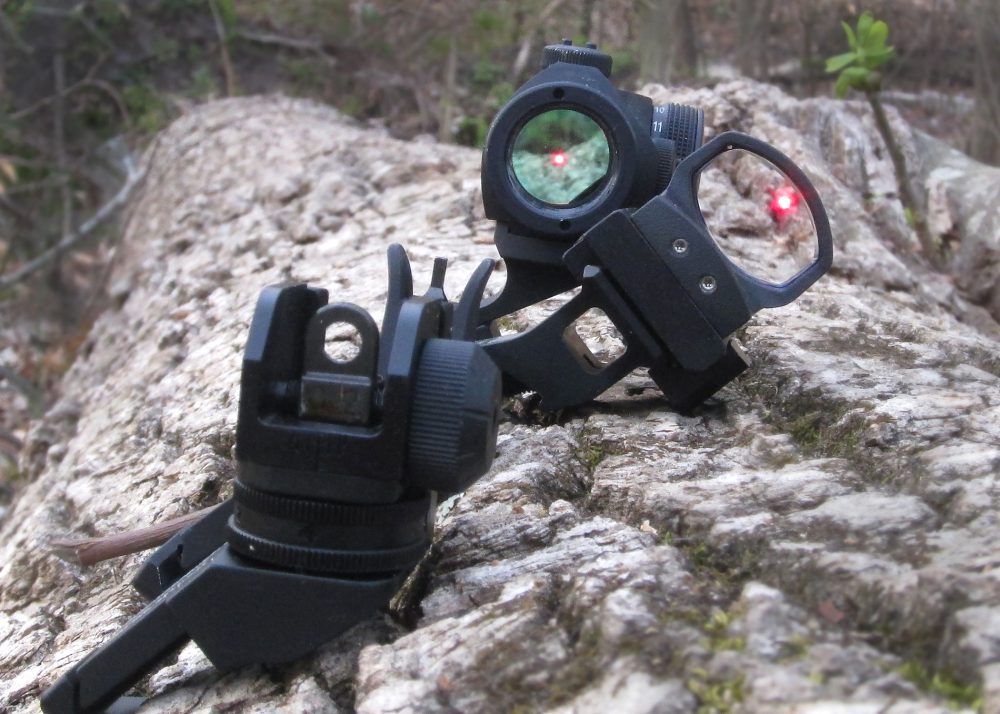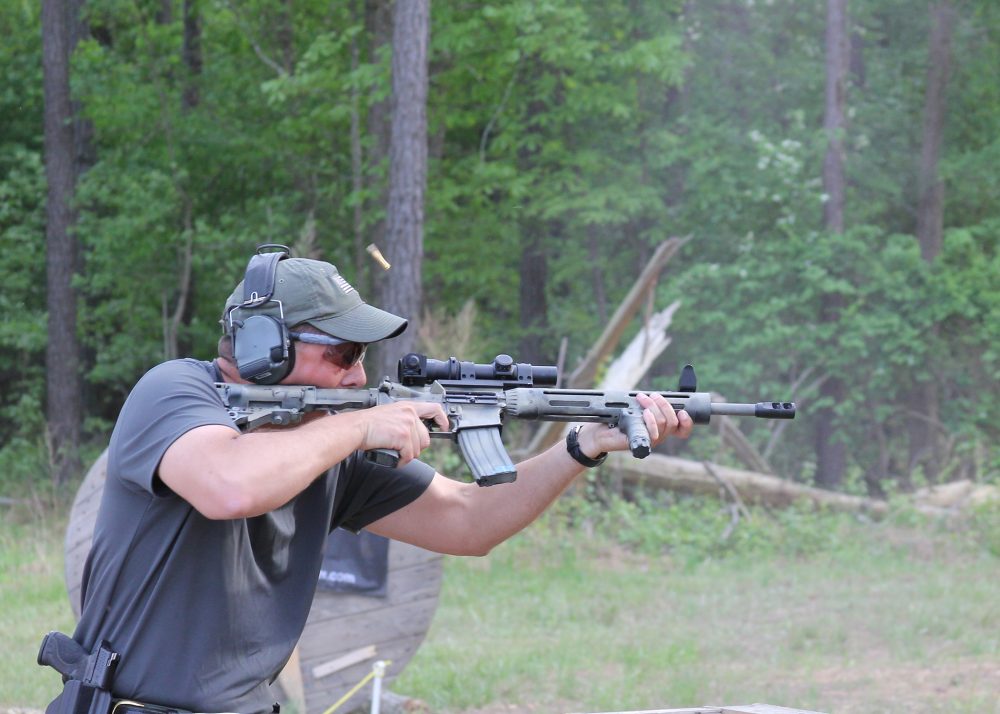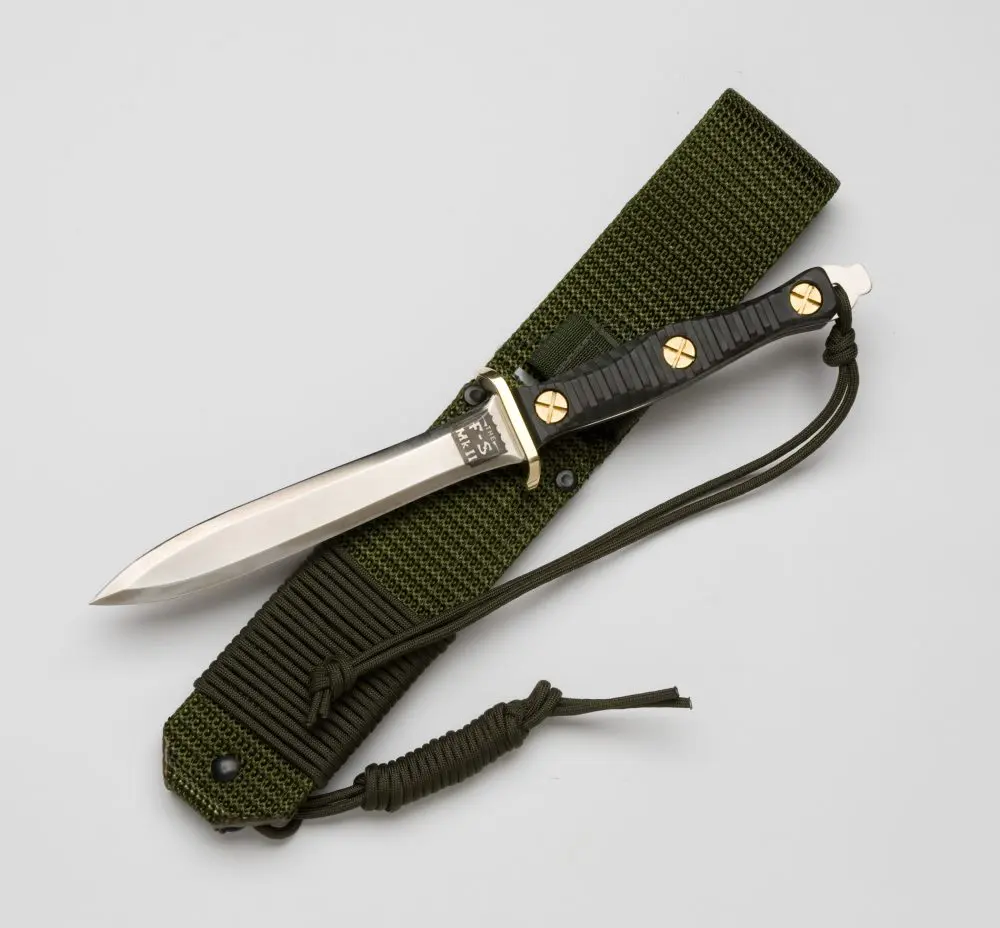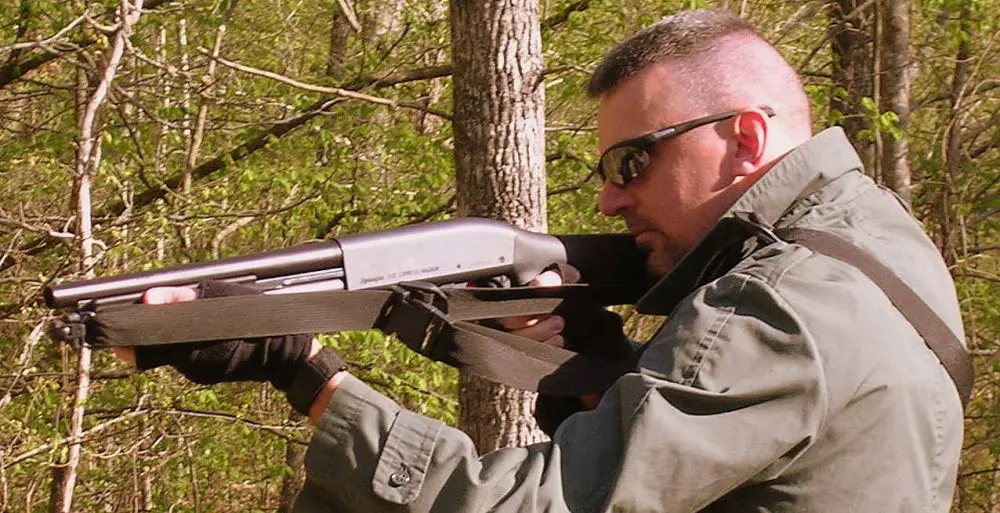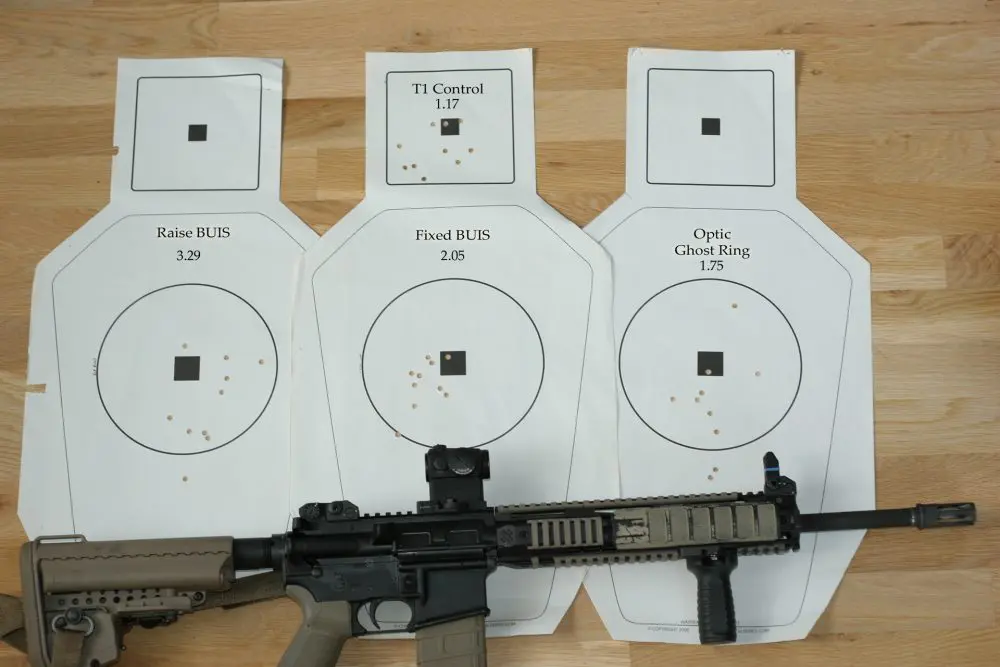The fielding of the ACOG/Rifle Combat Optic (RCO) a decade ago was a game changer. For the first time in U.S. military history, our troops had ready issue to a magnified optic that allowed identification and interdiction of targets that would have challenged the proven M16A2-series iron sights.
This played to significant advantage in the open deserts against the mid- to long-range fleeting unknown targets that characterized many of the conflicts in Iraq and Afghanistan. Commanders were enthusiastic about the increase in target discrimination as well as accurate long-range fires.
However, magnification does its job around the clock and, in a fixed-power optic, it is the only option.
Issue 4X32 Rifle Combat Optic has distinctly short eye relief, which combined with the fixed magnification, challenges close-range employment. SureFire RTS address this problem. Photo: DoD
Table of Contents
ACOG CHALLENGES
As the fight moved in close to more urban clearing and patrolling, the four-power of the Trijicon ACOG proved problematic. At across-the-room distances, with a snap cheek weld that doesn’t perfectly center in the scope’s “eye box,” the RCO shows the shooter a magnified image of about an eight- to ten-inch diameter. The eye relief of that optic is extremely short compared to most other riflescopes, at about an inch and a half advertised and maybe a smidge less in practice for some shooters.
This places the scope so near the shooter that seeing around the optic is difficult, forcing the shooter to rely more on the image in the scope than would be the case if it were mounted in the better three and a half inch territory. This leaves the shooter fighting through a soda straw at desperate fighting distances.
Improvised solutions emerged to address this problem, such as riflemen using lens covers on the front when entering a close-range fight to convert the RCO into an occluded eye gunsight. More just shot over the top of the rifle with degraded accuracy or suffered through the magnification’s “no free lunch” with loss of speed and situational awareness up close.
For several years, three-gun competitors have faced a similar problem of transitioning from mid- or long-range targets to multiples at handgun ranges when split seconds decide who pockets the prize money. For a number of years, ACOG models were among the top choice in optics there as well.
The solution that emerged on that front was an offset iron sight set at about 45 degrees on the handguard. The early ones were about a foot-long rail that essentially placed pistol front and rear sights on the handguard for close-range use. This was a workable solution on a match rifle, but few work guns would be able to sacrifice that rail space for a back-up sight.
SureFire Rapid Transition Sights are mounted offset to a 1913 rail, allowing shooter to flip his wrist to bring them into view and gain speed and better situational awareness up close.
SUREFIRE RAPID TRANSITION SIGHTS
SureFire’s Barry Dueck solved this problem by adapting the well-proven A2 system to a low-profile offset mount compatible with nearly any service-grade optic. SureFire Rapid Transition Sights (RTS) give the shooter the option to simply flip their wrist slightly to rotate the irons into the sighting plane as the environment dictates.
The front and rear sights mount to any standard 1913 rail with a slotted screw that has a healthy amount of thread locker pre-applied. The rear sight is the customary “0-2” large aperture and a smaller precision aperture available at the shooter’s choice with adjustments being the standard A2 non-locking wheels. The height over bore is the same or similar to traditional irons depending on the height of the handguard or float tube.
The RTS set is designed to clear most optics, with even large target turret windage knobs being safely out of the way. More applicable in a service role, the sights are designed to be compatible with current-issue rifle-mounted lasers.
I mounted a set on a Bravo Company EAG carbine behind a SureFire G2 in a Viking Tactics mount set at the one o’clock position. This would be the most challenging combination for those concerned with light/RTS compatibility, and the sights cleared the flashlight with room to spare. I mounted the set short to allow my support hand to easily access the light’s controls and to mimic mounting the RTS behind an IR laser on a standard M4 seven-inch rail.
This mounting decreases sight radius to near handgun length, and I was interested to see how well the system would fare at this slight disadvantage.
RTS are compatible with most common and issued lights, lasers and accessories. EAG carbine is set up with front sight mounted short to allow more natural hand access to white-light tailcap.
RTS IN ACTION
I shot the RTS against three scenarios. These were multiple targets on the move, reaction to scenario targets, and 100-yard precision. I shot each of these tests along with another shooter who has carried the M4/RCO combo into a couple of warzones to get some balanced feedback.
We each shot with almost no spin-up time on the system in order to get a sense of what the “raw” potential was, since the average serviceman, patrol officer or armed professional would likely get very little opportunity to train significantly on such a back-up system.
In shooting on the move, I jumped right to the worst-case scenario: aggressive right-to-left lateral movement with shots to an A zone target at seven yards. This is the shot that challenges most shooters even at shoot-house distances, where they either desperately fight the urge to pause for the shot or fail to hit well.
The RCO was very difficult to use in this scenario and required me to move more slowly than I would have liked to compensate for the magnified moving image. In contrast, the RTS allowed me to move at an aggressive speed and get the hits in one-third less time, with the difference amounting to about .75 second. Three quarters of a second allows quite a reactionary gap up close and might affect the outcome.
For the reaction drill, the shooters stepped off from behind a visual barrier and walked as in patrolling perpendicular to the targets, pivoting upon command to react to threats between 12 and 20 yards. The targets were Law Enforcement Targets overlapping terrorist targets with two photo targets per sheet. These have a great mix of color, light/dark, and shape that requires the shooter to process what he is seeing and place the shots.
Aimpoint T-1 in LaRue Tactical mount and Leupold Delta Point in Daniel Defense offset mount are alternative red dot solutions to the same application as the iron RTS.
Shooter one had very similar times with both sighting systems but felt he could speed up the RTS runs with a little more practice on flipping the RTS into view. He also liked the additional situational awareness/field of view they provided. The difference in my attempts averaged to a second and a half, with the RTS faster to similar hits.
The final test was a single prone headshot to a steel target at 100 yards. The long-range potential of A2-style iron sights is not really in question, since I have used that set-up out to well past max effective range with great results, and decades of Marines used them to qualify each year at 500 yards.
This was a check on the potential of the front sight short-mounted on the handguard and any effects of having the rifle canted in prone more than anything. Easy day. The EAG carbine sent a Black Hills 77-grain 5.56 dead center in the head area on the first and each subsequent attempt.
This result extrapolates out to torso hits to 200-plus yards and body hits farther. It allows the RTS to serve not just as a short-range sight but also as a back up in the event the magnified optic is damaged.
In further shooting with the SureFire sights on the EAG carbine as well as mounted at the end of a 12-inch rail on another rifle, I have found that the sights are my go-to 50 yards and in with a fixed-power optic or variable power “cranked up.” Even with a low-power variable scope down at the lower end, the RTS provide an advantage inside of 15 yards, particularly on multiple target scenarios where the shooter is driving the gun hard.
With variable-power optic onboard, RTS are still a great choice for multiple targets up close. Photo: J.W. Parent
APPLICATIONS FOR RTS
There are two broad applications for the RTS that jump out as useful. The first is as a choice for the shooter: magnified optic at mid-range and beyond and the RTS constantly available when the targets are in close. This is a significant capability plus-up.
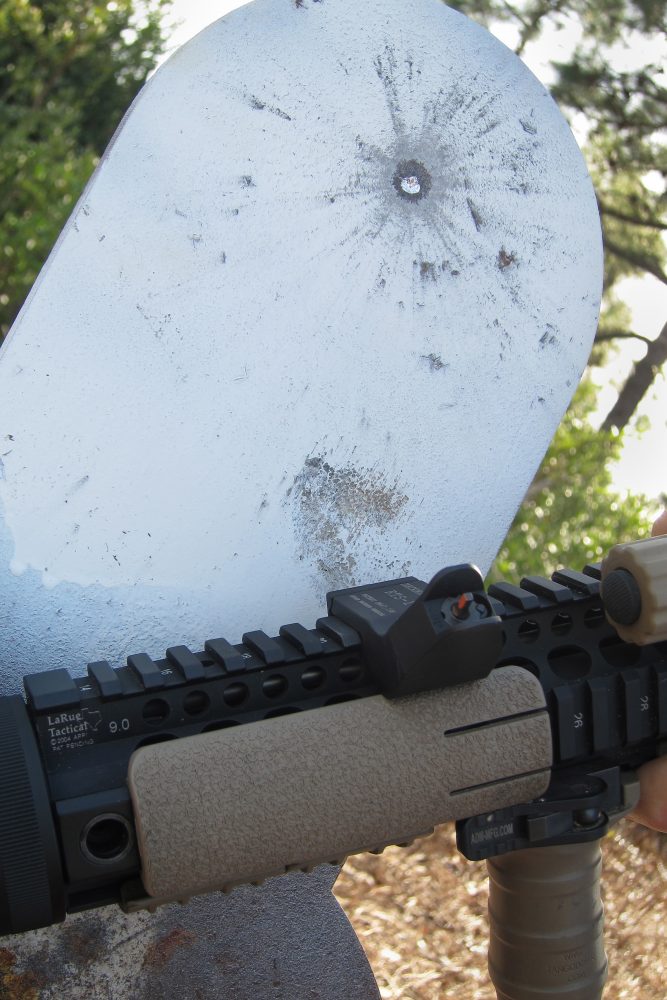
On a recent deployment, I ran an Aimpoint T-1 on my long gun most often, but there were times when I dithered over whether to mount the 4X32 RCO but chose not to because of the close-range liabilities. On one distinct occasion, I had a possible target at about 250 meters and was simply unable to positively identify whether he was carrying a rifle or not. At four-power, I am sure it would have been clear enough to make the call, but that was the trade-off in order to have red dot speed up-close, which was most often my greater concern.
With the RTS as an option, there would have been many more times that the RCO would have left the wire, providing capability and utility near and far.
The second utility is as a back-up sight. In the thick of the Iraq conflict, it was not uncommon for troops to purchase their own quick-detach mounts like the LaRue LT-100 for the RCO. The rationale was that, should the optic become damaged in any way, the rifleman could quickly get to personally purchased or unit issued flip-up iron sights.
This was a considerable expense for a contingency and in practice would require about six seconds to execute. Once mounted, the Rapid Transition Sights are always available and at the ready whether the primary sight goes down or is less suited to a given shot.
For the technologically inclined with more cash to invest, there are mounts that allow similar application to the RTS for an Aimpoint T-1 or Leupold Delta Point. Some will embrace the advantages of a dot over irons, while others will feel more comfortable with iron sights in the offset mode to bypass battery concerns in the back-up role.
One does have to be careful that an offset dot/mount combination will clear other mission-essential equipment as well as the RTS do.
The sights are a bit off-putting visually. It slightly challenges the observer’s sense of balance to see sights “off-kilter” with the rifle. If I’m perfectly honest, this probably kept me from trying the SureFire Rapid Transition Sights sooner.
However, pretty is as pretty does, and in this case the odd appearance is more than offset by capability. I suspect this is a case where today’s ugly becomes tomorrow’s cool as shooters see the benefit.
SOURCES:
SureFire, LLC
(800) 828-8809
www.surefire.com
Black Hills Ammunition
(605) 348-5150
www.black-hills.com
Bravo Company Mfg.
(877) 272-8626
www.bravocompanymfg.com
Law Enforcement Targets
(800) 779-0182
www.letargets.com
